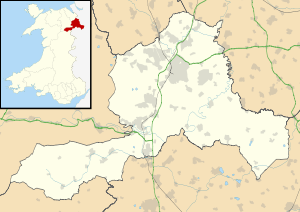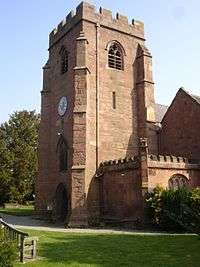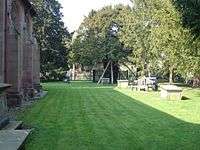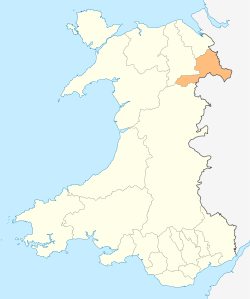Overton-on-Dee
| Overton-on-Dee | |
| Welsh: Owrtyn | |
 The main street of Overton-on-Dee |
|
 Overton-on-Dee |
|
| Population | 1,382 (2011) |
|---|---|
| OS grid reference | SJ372417 |
| Community | Overton |
| Principal area | Wrexham |
| Ceremonial county | Clwyd |
| Country | Wales |
| Sovereign state | United Kingdom |
| Post town | WREXHAM |
| Postcode district | LL13 |
| Dialling code | 01978 |
| Police | North Wales |
| Fire | North Wales |
| Ambulance | Welsh |
| EU Parliament | Wales |
| UK Parliament | Clwyd South |
| Welsh Assembly | Clwyd South |
Coordinates: 52°58′08″N 2°56′06″W / 52.969°N 2.935°W
Overton-on-Dee (Welsh: Owrtyn) is a large village and a local government community, the lowest tier of local government, part of Wrexham County Borough near the Welsh-English border. It is situated on the edge of an escarpment that winds its way around the course of the River Dee, from which Overton-on-Dee derives its name.
The community of Overton, which also includes the village of Lightwood Green and a number of small hamlets, had a total population of 1,276 at the 2001 census,[1] increasing to 1,382 at the 2011 Census.[2]
Geography
Overton-on-Dee is 7 miles (11 km) from Wrexham and exactly 22 miles (35 km) from both Chester and Shrewsbury. Its neighbouring villages are Bangor-on-Dee and Penley whilst the small towns of Ellesmere and Ruabon are only a short distance away.
The hamlet of Overton Bridge is a distinct settlement west of the village at grid reference SJ356426 above the Dee and the road bridge that carries the A528 road across the river.
History
One of Overton's earliest appearances in history was as one of the first targets of the revolt of 1294–95, led by Madog ap Llywelyn against the forces of the English King Edward I.
The village is situated in an exclave of the traditional county of Flintshire known as Maelor Saesneg (English: "English Maelor"), sometimes called "Flintshire Detached", and was the administrative centre of that part of the administrative county between 1889 and 1974. Between 1974 and 1996 Overton was administered as part of the short-lived county of Clwyd. Strangely, the community (parish) and county boundary between it and Erbistock (in historic Denbighshire) is, in part, on the west side of the river due to oxbow formation in the river. It is now in Wrexham borough.
St Mary the Virgin Church and its yew trees

The churchyard of St Mary the Virgin dominates the high street and is famous for twenty-one very ancient yew trees. The yew trees are traditionally one of the Seven Wonders of Wales and are commemorated in an anonymously written rhyme:
- Pistyll Rhaeadr and Wrexham steeple,
- Snowdon's mountain without its people,
- Overton yew trees, St Winefride wells,
- Llangollen bridge, and Gresford bells.
At 1,500 to 2,000 years old, the oldest tree predates the church, whose earliest stonework is probably Norman. In 1992 the village celebrated the 700th anniversary of the granting of a Royal Charter to Overton by Edward I in 1292 with a royal visit from the present Queen who planted a new yew tree.
Buildings and heritage
Overton has a fine collection of 18th and 19th-century buildings, many of which are listed as buildings of architectural or historic interest. Even the old telephone box has been "listed". The village centre is also designated as a Conservation Area.
Most of the village was once owned by the Bryn-y-pys Estate. The 1848 sale particulars, with 4,300 acres (17 km2) and a majority of the houses and farms in the village, run to several pages. It was made clear that the estate wielded "Great Political Influence", as without the secret ballot at general elections, the purchaser, who would be virtually everyone's landlord, was guaranteed of a place in Parliament.

There are several interesting buildings in the village including: the "Cocoa and Reading Rooms", a terracotta building of 1890, built to promulgate temperance, now the library; almshouses and a Victorian village pump.
Governance
An electoral ward in the same name exists. This ward stretches south east to Maelor South and at the 2011 census had a total population of 3,315.[3]
Recreation
The village has the usual sporting recreational areas of cricket, football, bowls and tennis. Overton is also an excellent rendezvous point for walkers as it finds itself on the map of the Maelor Way, a 38 km long-distance footpath; this in turn links up with Offa's Dyke Path National Trail at Bronygarth and the Sandstone Trail, Llangollen Canal, South Cheshire Way, and the Marches Way.
Further reading
- Gordon Emery – Guide to the Maelor Way (1991) ISBN 1-872265-98-7
- Gordon Emery – Curious Clwyd (1994) ISBN 1-872265-99-5
- Gordon Emery – Curious Clwyd 2 (1996) ISBN 1-872265-97-9
References
- ↑ Overton Community, Office for National Statistics
- ↑ "Community population 2011". Retrieved 19 November 2015.
- ↑ "Ward population 2011". Retrieved 19 November 2015.
External links
| Wikimedia Commons has media related to Overton-on-Dee. |
- St Mary The Virgin Church (Open Church Network)
- Overton-on-Dee website (Overton Community Council)
- photos of Overton-on-Dee on geograph

